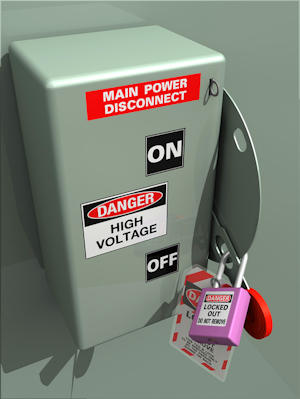Section 12 - Control of Hazardous Energy
12.A General.
Hazardous energy is any energy, including but not limited to mechanical (e.g., power transmission apparatus, counterbalances, springs, pressure, and gravity), pneumatic, hydraulic, electrical, chemical, nuclear, and thermal (e.g., high or low temperature) energies, that could cause injury to employees. > See Section 12.B.

12.A.01 When working on or near any system that produces, uses, or stores hazardous energy, a Hazardous Energy Control Program (HECP) is required.
- USACE-owned/operated facilities and activities must comply with ER 385-1-31, The Control of Hazardous Energy Program, and any regional HECP as well as local supplements in lieu of this section.
- Note: When USACE employees are on a site that is controlled by a contractor and are affected by the contractor-managed HECP (e.g., QA's on construction sites, etc.), they must comply with the contractor's HECP.
- On contractor-controlled sites:
- (1) The contractor must develop an HECP in accordance with this Section as well as all requirements of 29 CFR 1910.147, ANSI Z244.1, and ANSI A10.44. This HECP must be submitted as part of their Accident Prevention Plan (APP) to the GDA for acceptance.
- (2) The GDA and the contractor must fully coordinate all control activities with one another throughout the planning and implementation of these activities. Each must inform the other of their HECPs and Hazardous Energy Control (HEC) procedures, ensure that their own personnel understand and comply with rules and restrictions of the procedures agreed upon to be used for the job, and ensure that their employees affected by the HEC activity are notified when the procedural steps outlined in the HECP are to be initiated.
- (3) HEC procedures must be submitted to the GDA as part of the AHA for that phase of work. HEC procedures cannot be initiated until these procedures have been accepted by the GDA.
- (4) The Prime Contractor, as the Controlling Contractor, is also responsible for the HEC procedures of all their sub-contractors. The prime and the sub-contractors must fully coordinate all HEC activities with one another throughout the planning and implementation of work. Procedures to be used must be discussed and coordinated to insure all contractor, government or public persons are protected from hazardous energy, especially where crossover of contractor programs occur.
- When contractor work involving hazardous energy will be performed at or on a USACE-operated facility, the following must occur:
- (1) Contractors must submit their HECP to the GDA for acceptance;
- (2) HEC procedures must be submitted to the GDA as part of the AHA for that phase of work. HEC procedures cannot be initiated until these procedures have been reviewed by a person knowledgeable in HEC and accepted by the GDA.
- (3) The GDA and the Contractor must fully coordinate all HEC activities with one another throughout the planning and implementation of these activities. The agreed upon HECP and HEC procedures must be identified and documented.
- (4) Both parties must ensure that their own personnel understand and comply with rules and restrictions of the procedures agreed upon to be used for the job, and ensure that their employees affected by the HEC activity are notified when the procedural steps outlined in the HECP are to be initiated.
12.A.02 A preparatory meeting and inspection with the GDA and Contractor personnel must be conducted to coordinate HEC activities. This meeting/inspection must be documented.
- Employees must be trained and tested prior to working on Corps' Facilities where the Corps' HECP is in use to ensure that they are knowledgeable of the procedures.
- Contractors must ensure that all of their employees and sub-contractors are trained and knowledgeable in their HECPs.
- When HEC procedures affect USACE and Contractors, USACE and Contractor authorized personnel will participate to ensure that HEC programs and procedures are in place and coordinated.
12.A.03 Introducing Energy inside Clearance Boundaries. To provide for safe work practices where energy is introduced within boundaries of an existing clearance (e.g., commissioning equipment and/or testing activities, etc.), these activities will be coordinated with and communicated to all affected personnel.
- An AHA, by the contractor performing the work, must be created and implemented for these activities to ensure the integrity of the clearance boundary.
- Test procedures must be provided to the GDA prior to performing these activities.
Knowledge Check Choose the best answer for the question.
12-1. Who is responsible for the hazardous energy control (HEC) procedures of all sub-contractors?
You forgot to answer the question!
